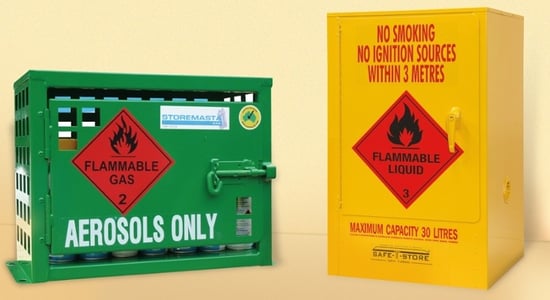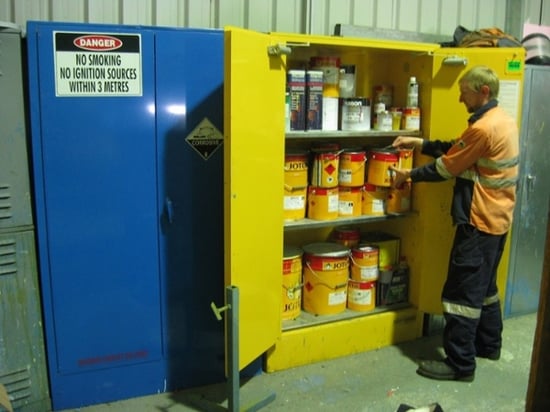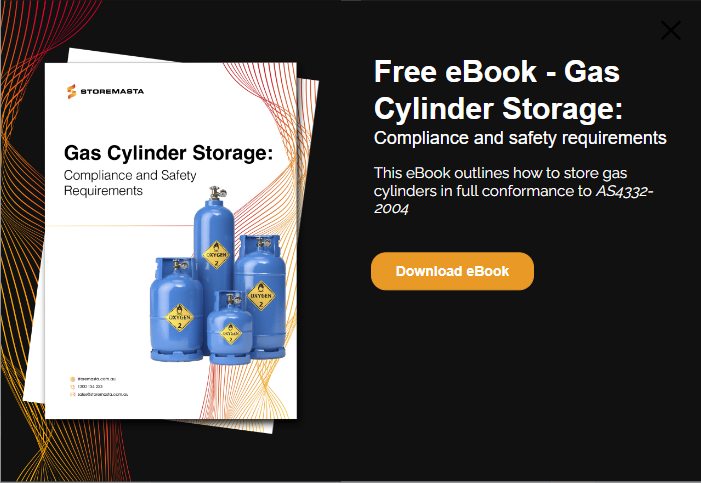As a convenient way of storing and dispensing hazardous substances, aerosol cans are found in just about every workplace. However, as aerosols are classified as Class 2 Dangerous Goods, they must be stored safely and legally. But how do you do that when there are so few references to aerosols in either the Australian Dangerous Goods Code (ADG) and the relevant Australian Standards? In this blog, we’ll be highlighting some of the hazards that surround aerosol cans — and offering our advice on how to store your aerosols at work.
What are the Hazards Associated with Aerosol Cans?
Sometimes it’s hard to believe that the little aerosol cans that we see every day — containing essential products such as paint, lacquers, cooking oils, fly spray, room fresheners or even deodorant — are actually classed as dangerous goods.
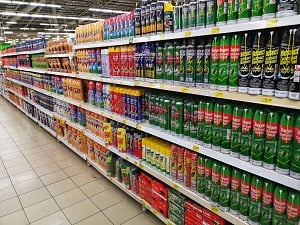
While found in almost every workplace, aerosol cans are actually Class 2 Dangerous Goods.
Unlike other compressed gases, aerosols present a complex range of hazards due to the chemical properties of the substances stored inside. This includes hazards related to the pressure of the gas, the potential waste hazard, and the physiochemical properties of the actual canister (such as the dispensing equipment, metal body of the can etc).
If you combine the chemical properties of aerosols with busy operations at a job site or workplace, you can find yourself dealing with a wide range of risks including explosions and human harm.
Workplace accidents involving aerosols include:
- Staff using a can of spray paint worked near industrial machinery which overheated the can and caused it to explode in the worker’s hand
- An aerosol adhesive can exploded and burned a worker after it was left too close to a heat gun
- A can of whipped cream burst through an unopened storage crate and impacted a staff member
- An aerosol can of cooking oil exploded and caused injury to two commercial cooks after it was left on a hotplate
- Workers were burned after shaking a can of paint which had overheated and exploded
- An explosion occurred at a busy cafe (large front window blew out) after the chef left a can of cooking oil too close to gas jets
Risks associated with aerosols include the can overheating, rupturing, being impacted, dropped or shaken — which can all result in the Class 2 Dangerous Goods causing an explosion.
The environment in which the aerosols are kept is a major factor in chemical compliance and safety. For example, if an aerosol can of spray paint is kept in a temperature-controlled hardware store it has less of a risk of explosion than if it was being used in an outdoor environment by someone such as a paving machine operator who is marking a hot bitumen road.

Heat can affect the safety of aerosol cans, so staff must be trained about the risks involved with handling or storing aerosols.
A common risk that is often overlooked with aerosol usage is the potential waste hazard of aerosols. This is particularly true if the aerosol can is past its use-by-date or has a defective nozzle that won’t allow the hazardous contents to be completely emptied out. Placing aerosol cans in with regular refuse could present a fire and explosion risk. These risk areas should be included as a part of your next chemical risk assessment.
Flammable Liquids Stores
Many workplaces follow the guidelines of Australian Standard AS 1940 - The storage and handling of flammable and combustible liquids and choose to store their Class 3 liquids in a flammable liquids cabinet. However, there are multiple types of flammable liquids stores that meet the requirements of the Standard.
These types of packages stores may include detached stores (with out without a roof), attached fire-separated stores and internal stores (not sharing a common wall).
In Section 3.7 of AS 1940, the Standard explains that aerosols may be stored (with chemical segregation) in a Class 3 store.
The Standard explains that:
Aerosols of Divisions 2.1 and 2.2 may be stored in a store for Class 3 dangerous goods if projectile protection (e.g. cages) is provided.
Section 3.7, AS 1940
However, this does not include storage of aerosol cans in flammable liquids cabinets due to the specific design constructions of these indoor stores. You must not store your flammable gas aerosols in a flammable liquids cabinet, as this can create hazards for your people and property.
Aerosols and flammable liquids require specific storage conditions to remain safe and compliant.
How are Class 3 Indoor Storage Cabinets Designed?
Class 3 Flammable storage cabinets are constructed specifically for the storage of flammable liquids.
To provide the risk control measures necessary for the safe storage of flammable liquids, safety cabinets must be constructed to provide:
- Heat protection – allowing a small amount of time for evacuation and emergency responders
- Vapour containment – providing an insulative shield to prohibit the spread of vapours into the workplace
- Spill containment – flammable cabinets are constructed with a spill containment sump to prevent chemical spills which may result in fire or explosion
Your flammable cabinet is constructed to meet the requirements of AS 1940 and provides heat protection, vapour containment and spill containment for your flammable liquids.
The Australian Standard AS 1940 explains the construction requirements for flammable storage cabinets:
4.9.2 Cabinet construction
The following requirements apply:
(a) The walls, floor, door and roof shall be of double-walled sheet steel construction, with a space of at least 40 mm between the walls. NOTE: This space may be either an air space or filled with non-combustible insulation.
(b) Any gaps around the doors and into the space between the walls shall be sealed as far as is necessary to prevent the spread of flame or heat radiation.
(c) The inner base of the cabinet shall form a liquid-tight compound at least 150 mm deep, and shall be designed to prevent the compound from being used as a storage space.
(d) Any shelves shall be perforated to permit free air movement, and shall be capable of carrying the maximum possible load.
(e) All leakage shall be directed into the lower compound.
(f) All cabinet doors shall be self-closing, close-fitting and held shut automatically by catches at two or more points.
(g) Where doors are equipped with a device to hold them open when necessary, they shall be released automatically as soon as the temperature exceeds a nominal 80°C.
(h) The materials of any components that are critical to the cabinet’s structural integrity shall not melt at temperatures less than 850°C. Seals or gaskets are accepted, but avoid their use if their failure could affect the protective function of the cabinet.
These features make cabinets unsuitable for the storage of aerosol cans, as aerosols require ample natural ventilation, as well as projectile protection. Aerosols, just like most classes of dangerous goods, also require effective chemical segregation from incompatible substances to avoid serious health and physiochemical hazards.
Interested in chemical segregation?
We recommend choosing to store aerosols in a compliant aerosol cage that is equipped with the correct dangerous goods and hazard signage.
Aerosol Storage Cages
One of the best things about dedicated aerosol cages is that they are specifically constructed so that you can store the cans loose — or within the original packing carton.
Aerosol cages don’t waste space, weight or construction costs on a spill containment sump, as this risk control measure just isn’t required for the safe storage of aerosols.
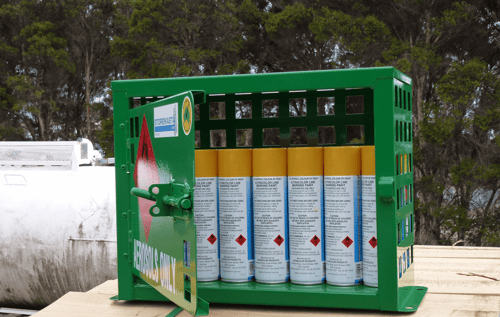
Constructed to meet the requirements of AS 4332, your aerosol storage cage provides natural ventilation with a heavy-duty steel cage construction.
Aerosol cages are designed and manufactured in accordance with the Australian Standard AS 4332 - The storage and handling of gases in cylinders.
Therefore, the cages are constructed with perforated walls to meet the ventilation requirements of the standard. AS 4332 also requires the aerosol cage to provide adequate projectile protection in the event of a workplace fire.
IMPORTANT: Storemasta manufactures aerosol cages to meet the requirements of AS 4332. Our range starts with a compact 18 can cage through to a large 625 can capacity. Each aerosol cage is manufactured from heavy-duty sheet steel and is finished in a high-build powder coat finish (anti-corrosion). Compliant aerosol cages also feature the relevant safety signage and warning placards.
How are you Storing Aerosols in Your Business?
Still unsure about dangerous goods storage? You can check out some of our other blogs about aerosols or look at our extensive product range that includes flammable liquids cabinets, aerosol cages, outdoor chemical storage containers and much more.
Your decision will ultimately depend on the unique operations of your workplace, which is why we highly recommend including aerosol can storage in your next risk assessment. If you need some help conducting your risk assessment, we have a handy guide that can help. Gas Cylinder Storage: compliance and safety requirements will help you apply a tested risk management methodology to the gas cylinders, aerosols and other chemicals held at your workplace or job site.
Joining the team as a Dangerous Goods Storage Consultant, Melissa Hampton became Storemasta's Marketing Manager in late 2021. With extensive knowledge and experience in chemical compliance, Melissa is responsible for leading the Marketing team and helping shape their marketing strategy. In her spare time, you can find Melissa hiking, swimming and enjoying the great outdoors in beautiful north-west Tasmania.
